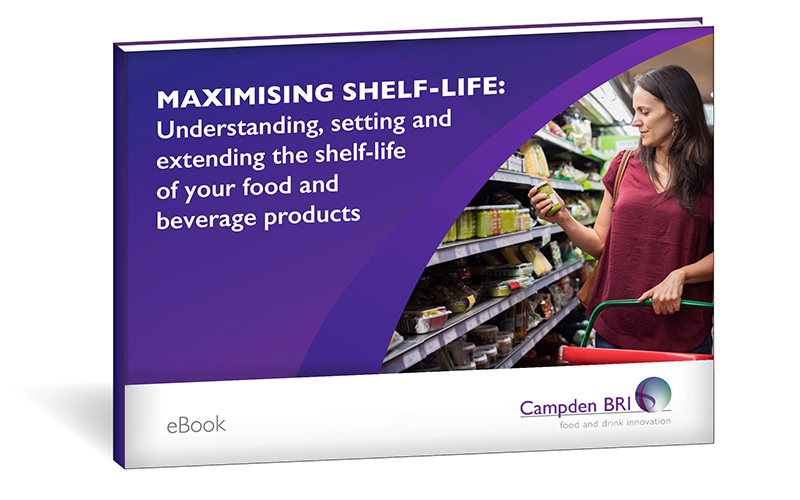
FAQs: your shelf-life questions answered
3 May 2023 | Shelf-life Team
We work on various shelf-life projects for clients, helping them to validate and verify their food and drink product’s shelf-lives from a sensory, chemical, physical, nutritional and microbiological perspective.
We also receive a wide range of queries about how to approach shelf-life testing and setting product shelf-life, as well as how to maximise and extend the shelf-life of food and beverage products.
Download the complete Maximising Shelf-life eBook, for free, to unlock the tools for measuring and maximising the shelf-life of your food and drink products whilst ensuring their safety and quality.

To share our knowledge and provide support, we have provided the answers to the shelf-life questions that they are most frequently asked by our members and clients.
Shelf-life testing protocols
Q1. How do you set a shelf-life protocol? What do you test for?
Answer from Linda Everis – Safety and Spoilage Section Lead:
The first step in designing a shelf-life protocol is to establish which factors are likely to limit the shelf-life. Will shelf-life be limited by growth of microorganisms, including both pathogens and spoilage organisms, or will shelf-life be limited by only sensory/quality changes.
This will be dependent on what the product is and the key characteristics of the product such as pH, water activity, the processing applied, and packaging, as well as the length of shelf-life required. It is also necessary to consider whether pathogens may survive in a product as low numbers of some pathogens can be sufficient to cause illness.
Q2. How many samples do you test? And how frequently?
Answer from Linda Everis – Safety and Spoilage Section Lead:
This will depend on the intended shelf-life of the product. It is recommended that triplicate samples are tested at each timepoint as it’s more reliable than testing a single sample. The number and frequency of the test points is dependent on the shelf-life of the product and what tests are required. A product with a short shelf-life will be tested more frequently than a product with a long shelf-life, with careful consideration given to the spacing of the tests to ensure the correct data is gathered.
Food / beverage safety
Q3. What are the distinctions between producing a safe product and validating its shelf-life?
Answer from Sarah Chapman – Product Development Specialist, Linda Everis – Safety and Spoilage Section Lead, and Lynneric Potter – Food Packaging Technical Lead:
Sarah:
The testing considerations for shelf-life evaluation are not for setting routine testing criteria – food business operators must set other criteria for their routine testing. Such as positive release testing and HACCP verification testing.
Linda:
For example, challenge testing may be performed to establish at what point a particular pathogen (if it were to be present) will reach unacceptable levels within a product. Separate to this will be food safety and quality management system control measures in place to prevent and limit the presence of this pathogen and other microorganisms.
Sarah:
The shelf-life of a canned meat or of UHT milk in a carton may relate to non-microbiological limiting factors, such as migration of tin into the product, or other deteriorations related to sensory or other quality attributes. However, due to the nature of the products (and the microorganisms that they can support the growth of), there will need to be controls in place to prevent, limit and kill microorganisms, verification that they have been implemented as validated (in the case of, for example, the sterilisation process), and routine / due diligence microbiological testing.
Lynneric:
What’s more, whilst the packaging testing will form part of the shelf-life testing, routine testing will need to include ensuring integrity of the packaging, and that the packaging meets the necessary specification.
Whilst we are drawing the distinction here between shelf-life and the overall food safety management system, here is an example of where this intersects – because the shelf-life could be compromised if the packaging used in practice does not meet the specification of that used in the shelf-life validation testing.
Sarah:
We often receive queries where distinctions appear to have been blurred between validating shelf-life and ensuring food safety more broadly. Our wide-ranging expertise allows us to provide a holistic approach and support our clients with both elements.
Sensory testing
Q4. What test methods are applied when setting shelf-life from an organoleptic perspective?
Answer from Susan Rogers - Sensory Testing Services Manager:
Our highly trained and experienced sensory panels apply descriptive methods – such as Quality Grading, to objectively describe changes in product quality over shelf-life. Trained assessors evaluate products in terms of their appearance, odour, flavour and texture/mouthfeel, ideally when compared to a control/reference.
As well as the descriptions – the qualitative data – the sensory attributes are also quantified by the panel. Individual and overall quality grades are awarded to the samples at each assessment time point over shelf life. The quality grades we apply are from an established 1-9 quality rating scale.
Other sensory test methods can also be applied, depending on our client’s objectives and test requirements. For example discrimination methods, such as ‘Difference from Control’ – where a selected panel of up to 20 assessors evaluate the stored test samples against a labelled control sample. In doing this, the assessors quantify the size of the difference between the control and test sample. This is quantified on a 1-5 scale for overall difference or each attribute.
Measuring rancidity
Q5. At what peroxide value / free fatty acid content / hexanal content would my product be rancid?
Answer from Rob Levermore – Flavour and Taint Group Manager:
The answer will vary from product to product, depending mainly on the amount of fat in your product and how strong the natural odour and flavour of the product is.
If a client wanted to establish values for their product, the way to do this would be to carry out analytical testing alongside sensory testing to establish the point at which the product becomes unacceptable by sensory testing, and what analytical values (or ‘limit values’) the product has at that point.
Analytical testing can also be used comparatively, by comparing different conditions / treatments of a product during a shelf-life trial. In this instance, even if the ‘limit values’ for the product hadn’t been established, you could still compare the analytical results to see if a change to the product has made it more or less susceptible to rancidity.
The impact of packaging
Q6. Can modified atmosphere packing extend the shelf-life of my product?
Answer from Lynneric Potter – Food Packaging Technical Lead:
Changing the atmosphere in the headspace of a package can reduce biochemical changes, retard microbial growth and maintain organoleptic qualities whilst reducing the need for additives.
But, being able to use modified atmosphere packing to extend shelf-life in practice depends on the quality of your ingredients, storage temperature, hygiene, packaging material properties and the gas mix you are using.
Q7. I am changing from a multi laminate to a recyclable film – will this impact on my shelf-life?
Answer from Lynneric Potter – Food Packaging Technical Lead:
Firstly, you need to understand what the shelf-life limiting factors of your product are and the properties of your current material that are required to maintain that shelf-life.
These key properties can then be compared to the new material to see what differences there are and how this may influence the shelf-life. Important properties of a packaging material may include, for example, strength and its barrier properties.
Applying predictive modelling
Q8. How can predictive microbiological modelling be used in shelf-life evaluation?
Answer from Linda Everis – Safety and Spoilage Section Lead:
Predictive models are a useful tool in the shelf-life evaluation process. They can be used to quickly assess the potential for pathogens and spoilage organisms to survive and grow under the conditions of the product. They can also be extremely useful at the product development stage, for quick evaluation of the impact of recipe changes and other ‘what if’ scenarios.
There are a number of predictive modelling tools we can use to give an indication of shelf-life under different storage conditions. For microbiology we have the Campden BRI Forecast predictions for spoilage microorganisms and make use of the ComBase tool for pathogens.
Q9. We are about to launch a product and don’t have time to wait to determine the shelf-life, is it possible to predict what the shelf-life will be?
Answer from Linda Everis – Safety and Spoilage Section Lead:
Predictive models are useful tools to give an indication of likely shelf-life but should be validated by practical studies. Predictive modelling also has its limitations. For example, it does not factor in changes in water activity and pH over time, differences in structure across a food sample, the presence of competing microorganisms or the presence of naturally occurring antimicrobials.
Accelerated shelf-life testing
Q10. How can product shelf-life of foods be established quickly? What protocol should be used for accelerated shelf-life testing? What conditions and timescales should be used?
Answer from Bijol Bakhai – Processing and Storage Food Chemist, Susan Rogers – Sensory Testing Services Manager, Lynneric Potter – Food Packaging Technical Lead and Linda Everis – Safety and Spoilage Section Lead:
Bijol:
Increased storage temperature is generally used as a condition for accelerating the natural deterioration of the product. Although it can be difficult to determine the rate of product deterioration under accelerating conditions, mathematical models, such as the Arrhenius model, can be used to link the storage temperature to the rate of physical and chemical reactions and product deterioration processes.
Exposing the product to high intensity light may be used in relation to, for example, colour change or vitamin degradation. Increasing oxygen levels or humidity of the storage conditions may be applied in some cases where oxidative rancidity of fats can be a concern.
We can help clients to determine an accelerated shelf-life testing protocol for their product by conducting various real time and accelerated studies, in order to model the comparisons and establish the most representative relationship between the storage changes and the product deterioration timescales.
Susan:
We have the storage capacity as well as the capability to conduct accelerated shelf-life testing on food and drink products, applying trained sensory panels and analytical measures. However, this relies on the client advising on the forcing conditions to apply (temperature, relative humidity and lighting) and duration of the study, as this is specific to individual products. We would also recommend a real time study be completed under normal storage conditions, run in parallel with the accelerated storage trial.
Lynneric:
Accelerated shelf-life testing generally requires storage at higher temperatures but this can also impact on the packaging material allowing greater transfer of moisture and oxygen through the material and interactions between the material and the food which may not occur at lower temperatures.
Linda:
It should also be noted that accelerated shelf-life testing should not be used to determine microbiological safe shelf-life because the changes to storage conditions may affect the relative speed of microorganism growth and chemical reactions and can even give a false sense of which microorganisms will grow or limit the life of the product.
We are here to help
Considerable expertise and experience is needed to guarantee all the necessary considerations are included in the setting or extension of a product’s shelf-life. Where a manufacturer does not have the time, expertise or resources in-house, we are here to help.
The testing considerations discussed here are not exhaustive, are in relation to shelf-life evaluation only (i.e. not for setting routine testing criteria), and are as a guide only – they should not be followed without gaining expert advice. Products need to be considered on an individual basis, as in some cases other tests may be required to ensure safety and legal compliance and quality, which must be assured throughout shelf-life.
Join those benefitting from our support
The food and drink industry presents a fast-paced, constantly changing environment that requires creative thinking, quick responses and cost-effective solutions. We can help overcome these challenges and support you in maximising shelf-life to get the most out of your products.
We take a holistic approach to shelf-life testing, and provide our members and clients with tailored, expert support in all areas of shelf-life evaluation, maximisation and extension. Using state-of-the-art facilities and the latest methods and technology, you can be sure of a high-quality service.
Get in touch to join those already benefitting from our expertise in microbiology, chemistry, sensory, regulatory and product innovation services.

About Linda Everis
Linda has a wealth of knowledge, experience and expertise from her time in Microbiological Analytical Services and Microbiology Safety and Spoilage. She joined Campden BRI in 1995 as a Senior Technician in the Microbiological Analytical Services group having graduated from the University of Wales Aberystwyth with a BSc in Biology.
Alongside the expert support that Linda provides to our members and clients, Linda conducts project work and research, and has been author and co-author of articles and papers for a variety of microbiological publications and Campden BRI reports.
Linda also lectures on shelf-life, challenge testing and predictive microbiology for our many training courses and seminars.

About Rob Levermore
Robert Levermore has worked for Campden BRI since 1993. Rob began his career at Campden in the Biochemistry Section of the Chemistry and Biochemistry Department, where he assisted with a number of research projects, before moving into the Flavour and Taint Group in 1996, becoming manager of the group in 2005.
As Flavour and Taint Group Manager, Rob undertakes a wide range of analyses, covering both targeted analytical work for specific tainting compounds, and general screening of samples where a tainting odour or flavour has been detected, but its source is not known. He also provides expert advice on the results obtained, producing interpretative reports to assist clients in finding the root cause of any problems, and avoiding similar occurrences in the future.
Rob is also heavily involved in Campden BRI's work with Her Majesty's Revenue and Customs, providing both analytical services and technical advice. He also represents HMRC as the UK chemical delegate at a range of European Union meetings, both in Brussels and elsewhere.

About Lynneric Potter
Lynneric has worked at Campden BRI since 1999, and has spent the majority of this time specialising in all things packaging, including supporting members and clients, managing contract projects, and conducting research.

About Susan Rogers
Susan has a wealth of knowledge, expertise and experience in sensory science and has worked at Campden BRI since 1999. Her first sensory role was Discrimination Projects Manager, working predominantly with taint investigation of food, and managing the Defence Food Services Quality Assurance contract (providing sensory, technical and analytical food testing services for the UK armed services). Susan has also worked as Sensory Projects Manager (Discrimination and Descriptive Projects) and is currently Sensory Insights Section Manager responsible for new business development and managing the sensory project teams activities.
Alongside supporting various client projects through sensory and other data, Susan also lectures on our sensory training courses.
How can we help?
We have more than 200 scientists and technical experts collaborating on a wide range of projects every day. Get in touch if you’d like their support with a shelf-life project.
Download our FREE Maximising Shelf-life eBook today!
Explore different strategies to maximise and extend product shelf-life, without compromising safety or quality.






